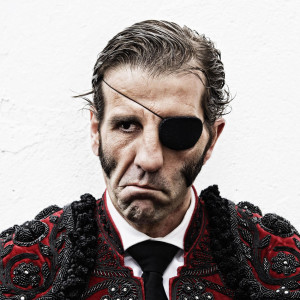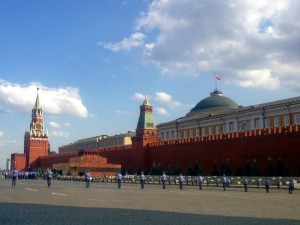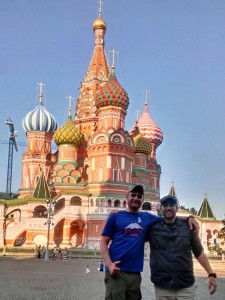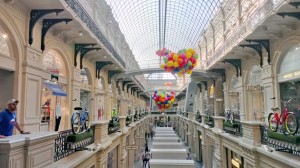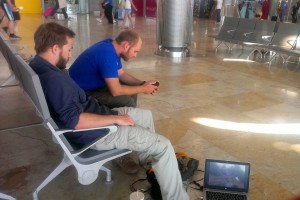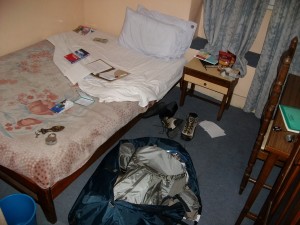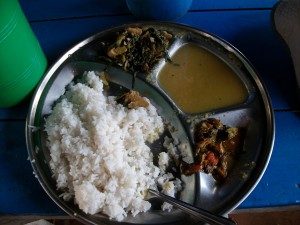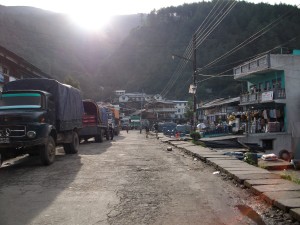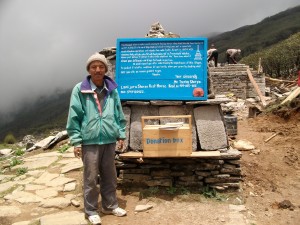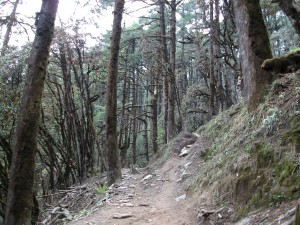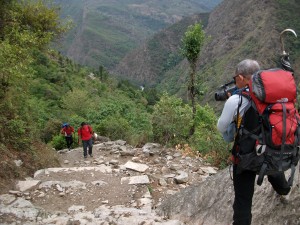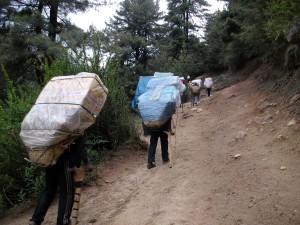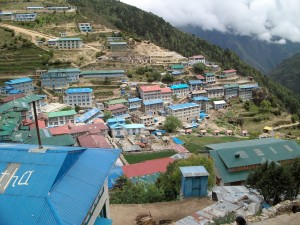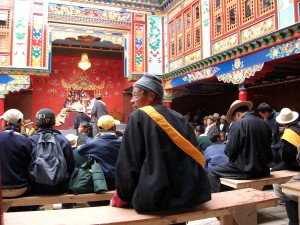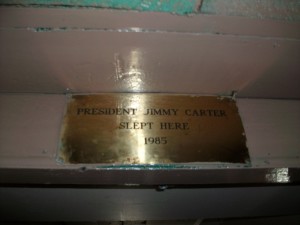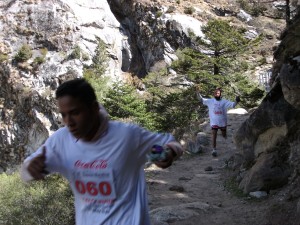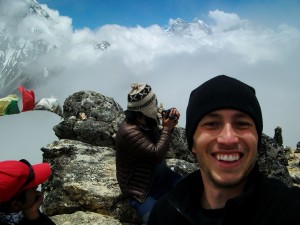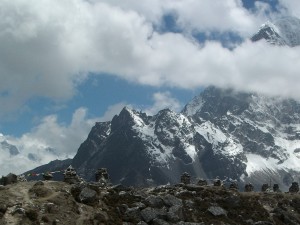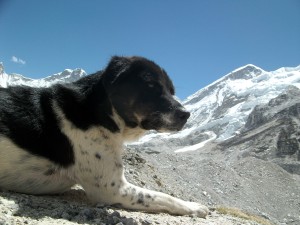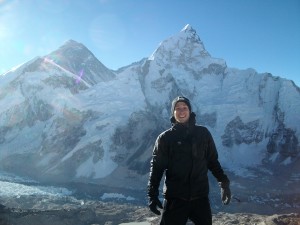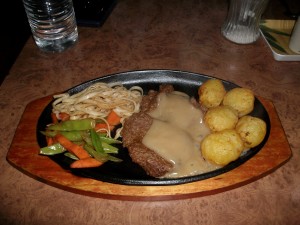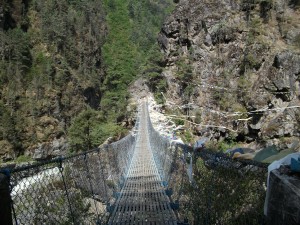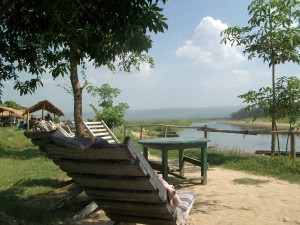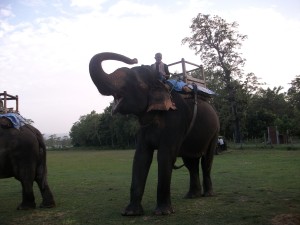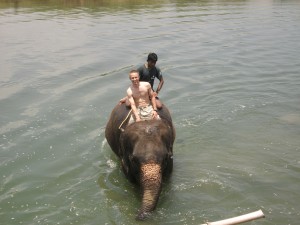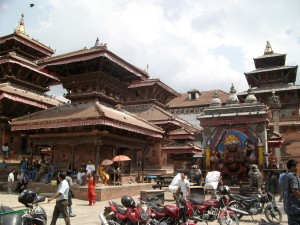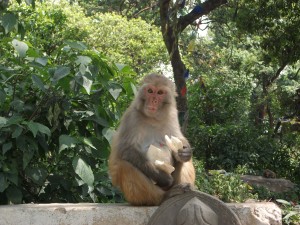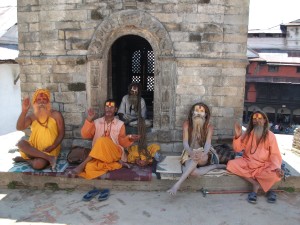“Every morning the bulls that are going to fight that afternoon released from the corrals on the far side of town and race through the long main street of the town to the bull ring with all the young bucks of Pamplona running ahead of them! A mile and a half run – all the side streets barred off with big wooden gates and all this gang going like hell with the bulls trying to get them…By God they have bull fights in that town…It isn’t just brutal like they always told us. It’s a great tragedy – and the most beautiful thing I’ve ever seen and takes more guts and skill and guts again than anything possibly could.”
-Ernest Hemingway, July 1923-
As part of a two-week journey to climb Mt. Blanc, Mt. Elbrus, and Run with the Bulls, my friend Taylor and I arrived in Pamplona, Spain on July 11th.
July 11th – The Arrival
After more than 24 hours of planes, trains, automobiles, and layovers, we finally arrived in Pamplona, Spain at 6:00pm on Thursday. We stayed at the home of a friendly couple, Ella and Eneko, who rented out rooms in their apartment during the San Fermin festival. Upon hearing of our plans to run in the morning, they offered up advice on where to go and when to show up. Eneko has long lived in Pamplona but has never run himself because the race is “muy peligroso”. Nonetheless, he tells us exactly where to go, and lays out a plan for us on the city map.
We decided to go into town, map in hand, and walk the course in search of an appropriate starting point for the morning run. We walked to the bus station with another group who were staying in the home. They showed us the bus route to the town center and pointed us in the right direction for the Running of the Bulls. On the way to the course, we stopped by a local bar to enjoy some pinchos for dinner. Pinchos are an assortment of small finger-foods, in our case fried ham and shrimp.
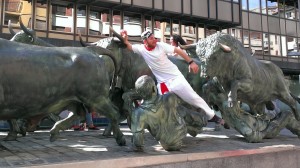
Our taste buds satisfied, we headed over to the city walls of Pamplona. As the capital of the ancient Kingdom of Navarre, Pamplona’s walls are fortified in stone and protected by a moat and drawbridge. Near the edge of the city wall we found the corrals where the six fighting bulls and nine steers would be held just before the start of the race. From there we walked uphill along the course to the Plaza del Ayuntamiento where the historic town hall building is located. It was from this location that we would be waiting at at 7am in the morning until the Policía cleared the course of drunks and debris. From town hall, we continued onward to Dead Man’s Corner, a sharp right turn where bulls often get turned around becoming an extremely dangerous situation. Just beyond the corner is Estefeta street, a long narrow corridor that runs nearly a half mile to the Plaza de Toros bull ring. We picked a spot on Estefeta just past the corner and decided we would begin our bull run from there. This would allow us to run with the bulls nearly the entire length of the course, yet avoid the dangerous corner where many bulls have turned backwards on the course and gored men to death.
We bought our red bandanas and waistbands in the market and stumbled upon the nightly parade. It seemed that everyone who had run that day was celebrating in the parade by dancing behind the band and indulging in sangria. We joined in the procession for a lap around the square and enjoyed the people watching. Most had been drinking all day and their white clothes had been stained purple with wine. Hoping to keep our whites clean for the morning run, we parted ways with the hooligans and headed back for the evening. After all, we had only one shot at the race and it was sure to be another early morning.
July 12th – The Run
We awoke at 6am sharp, dawning our white pants and t-shirts, red bandannas and waistbands. I wore my Texas state flag bandanna in hopes the bulls would respect my inner cowboy, while Taylor wore his toughest motorcycle bandanna for intimidation effect. We caught the first bus into town and were waiting at Town Hall just as the sun began to rise.
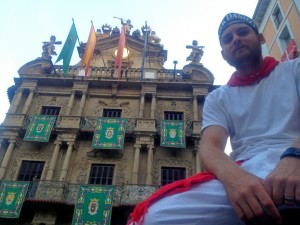
There were people everywhere including a number of drunks who had yet to retire from the night before. We knew that the Policía would go through and weed out the riffraff, so we needed to stay in the square until ten minutes prior to the race before moving into our spot on Estefeta street. Sure enough, when the time arrived, the drunks were cleared as well as a few runners who had snuck in with cameras (not allowed in the race). We hid ours in our pockets until the cops were gone. At 7:50am the course was opened up and we hurried down to our pre-planned starting point. The street was crowded with young runners and the balconies were covered with curious onlookers. I stretched out my legs, made my peace with God, and waited for the gunshot to signal the bulls had been released.

The tension in the air was at its peak as we and our fellow runners prepared to run with the bulls, and then the first gunshot fired. The second gunshot signaled that the last of the bulls had left the corral, and we knew it was a matter of seconds until a herd of angry beasts rounded the corner towards Estefeta. The crowd of runners became a bouncing sea of red and white as we jumped up and down to see down the street in anticipation of the oncoming herd. Taylor and I attempted to review our strategy, but before we could finish there were six tons of cattle rounding the corner and barreling down the street towards us. With my heart leaping into my throat I shouted the only word that I could think of in the moment…”BULLS!!!”
I shot out onto the street just as the bulls were approaching and immediately recalled that the people are the hidden danger of the race. The crowd was in a frenzy and runners were shoving and tripping over one another. My focus was just as much on dodging runners as it was bulls. As the bulls came up from behind, I was leaping over trampled runners to avoid the same fate. Within seconds, the last of the bulls was now passing and I was almost in the clear to run on safely towards the coliseum.
Just as the final beast passed, a fellow runner was tripped up and fell directly in front of the bull. The bull crashed over the runner and landed an angry mess on the side of Estefeta street. In the moment that the bull had fallen, I looked over and made eye contact with the furious bovine. For a second, time stood still. I recalled everything I had heard about the dangers of the race when the bulls crash and get turned around. In a rush, I ran away from the bull towards the far side of the street where a couple dozen other runners were pinned up for refuge. The nightmare became a reality when the half ton animal stumbled to its feet and turned our direction.
Instinct shocked through my nervous system and I exploded out of our corner and backwards down the street. The shrill scream of a frightened women could be heard from the balcony overhead. As I ran backwards, I watched as the bull began to gore its first victim. At first, it seemed as if the man might escape, until he tripped again and the bull came back with a vengeance. The bull, known as Langostero, thrust his pointed horns into the mans legs, shredding away his pants and tossing him about like a rag doll. This gruesome scene seemed to continue for an eternity until Langostero was distracted and fellow runners were able to pull the battered man to safety.
I continued on towards the arena, following at a safer distance from the enraged bull. Twice more along the way, Langostero would turn back towards us and the balconies would erupt in screams. Each time we would turn abruptly to avoid another unplanned bullfight. The final time was in the alley entrance to the arena in which I hopped the wooden barriers for safety. Here, Langostero pinned a man against the opposite barrier, piercing his horn through the man’s shoulder. Some brave runners once again distracted the bull and led him finally to the Plaza de Toros. I followed into the ring as the bulls were herded off to their pins. 20,000 onlooking spectators cheered at the completion of the week’s most violent bull run. I found Taylor, whom I had lost in the panic, and discovered that we had been no more than 20 feet apart throughout the entire run.
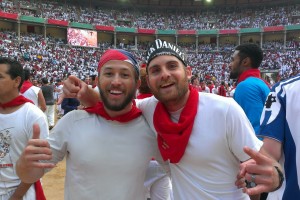
Once the Running of the Bulls was complete, smaller fighting bulls in training are released into the ring one at a time to have their way with the runners. We chose to stay around and practice our amateur matador skills. (These smaller bulls had their horns corked and taped for safety) Despite the smaller size of the training bulls, they would come exploding out of the gates with more force than an NFL lineman. Many unfortunate runners were trampled or knocked out by the young bulls’ ferocious power. The runners make a game out of attempting to tap the bull on the back without getting rammed by his blunted horns. We joined in the game and were able to slap the bulls twice each. One guy was rammed so hard that his head split open requiring stitches. Another girl was run over by the bull so fast that she received a concussion. After a good 30 minutes of tempting our fate with the training bulls, the morning was over and we had survived with little more than a scratch. We took a few pictures, and headed out of the coliseum, but not before I did my best Gladiator impression. In the words of Maximus, “Are you not entertained?!?”
Watch the full Run below. (Caution to those who are squeamish) You will find me at the 6:02 and forward mark wearing the blue head bandana in the bottom center of the screen.
July 12th – The Fight
Following the Running of the Bulls we celebrated by drinking a pint of Spain’s finest beer. I don’t always drink beer in the morning, but when I do, I prefer to run with the bulls first. Stay thirsty my friends. After the post-run adrenaline crash, we went back to the apartment to sleep until the evening’s bullfight. That evening we dined on some Spanish chorizo and ribs and then made our way back to the Plaza de Toros, but this time as spectators.
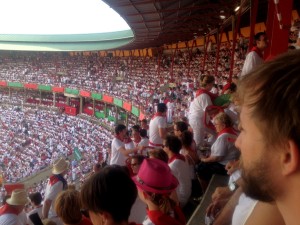
The bullfight is steeped in tradition. There are six fights, one for each of the bulls from the morning’s run. The King of Navarre sits on his throne and armored horses enter the ring in a royal procession. The matadors follow and the crowd of 20,000 erupts in cheers. Each fight lasts about 20 minutes as the matador dances about the bull with the skill of an artist. With little to protect him except his experience and his cape, the matador skillfully distracts the bull from one side to another until the bull is exhausted and the matador inflicts his final, swift blow. With a single sword plunge to the heart, the fight is ended, the ear is removed as a tribute, and the armored horses remove the bull to be served on the local menus. This bloody affair may seem a bit grotesque or cruel if it weren’t for the local legend of matador, Juan José Padilla.
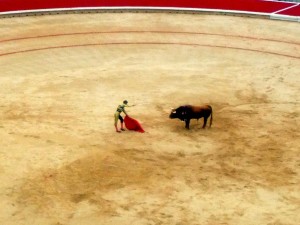
Juan José Padilla is the famed one-eyed matador who nearly lost his life at a bullfight in 2011. He received a horn through the jaw and out the left eye leaving him paralyzed on one side of his face; a reminder that every bull has his day and no matador has it easy. Padilla wears an eye patch and continues to fight more determined than ever. On this day, the skillful Padilla would fight Langostero, the bull who hours earlier had taught the runners to respect his fury. This match was almost poetic in nature. Bullfighting matador turned gore victim returns to the ring to fight the week’s most vicious of bulls. Padilla, having tasted the pain of defeat, respected the power of the bull. He skillfully flung his red cape before Langostero, narrowly dodging a horn to the side before masterfully spinning and bringing the bull around again. Padilla was a master of his craft, indeed, and had met his match in Langostero. After dancing on the line of fate, Padilla finally drew his sword and lay the beast to rest. Juan José Padilla bowed his hat to the King, to the crowd, and to the bull. The bravest man who ever lived.
